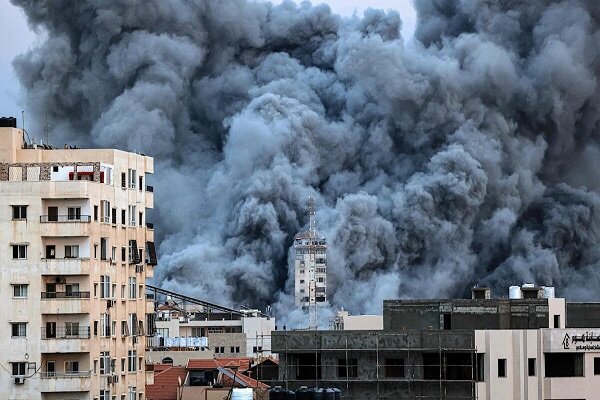Fragile Ceasefire: Why Hope for Peace in Gaza Remains Dim

According to webangah News Agency, led by Benjamin Netanyahu, the Israeli regime views Trump’s Gaza plan as a decisive step toward ensuring its long-term security. Complete disarmament of resistance groups and eliminating military threats are prerequisites for the gradual withdrawal of Israeli forces from Gaza. At a White House press conference on September 29, 2025, Netanyahu emphasized that Gaza must become a “weapon-free zone” while maintaining permanent security boundaries. In contrast,Hamas interprets this plan not as an end to occupation but as continuing Israeli dominance.
Hamas leaders in Doha and Istanbul consider this plan “an opportunity for negotiation,” noting that it lacks guarantees for the full withdrawal of Israeli troops and limits the role of the Palestinian Authority. These disagreements-rooted in past experiences such as failed ceasefires in 2023 and 2025-have made the truce fragile. These conflicting interpretations not onyl halt progress on phase two but also breed new tensions, with Israel using media and diplomacy to justify its stance. Ultimately, this ceasefire seems more temporary and risky than genuinely peaceful.
Israel’s Perpetual Pretext-Making Undermines Peace
A critical obstacle in implementing Gaza’s ceasefire has been israel’s repeated pretexts regarding handing over bodies of captured soldiers. Under phase one of trump’s plan, Hamas was obligated to return corpses of 28 deceased captives by October 13, 2025; however, only nine have been delivered while others remain buried under Gaza’s rubble caused by israeli bombings. Hamas states it requires specialized equipment for recovery operations amid destruction; Israel interprets these claims as non-compliance and continues blocking humanitarian aid through Rafah crossing.
This approach-justified by Netanyahu as “defensive measures”-not only violates agreements but aggravates Gazans’ suffering amid UN warnings about worsening famine conditions. Simultaneously occurring, Hamas accuses Israel of sending unrelated or bound Palestinian bodies back-a cycle further complicating matters. Israel’s pretexts stem from its strategy to retain leverage at negotiations and reveal little genuine intent toward building trust. While families in Tel Aviv protest demanding returns for their loved ones,Gazans face a humanitarian crisis ticking into deeper despair.Such contradictions turn the ceasefire into political maneuvering that dims hopes for lasting peace since each delay fuels potential breaches.
The Illusory Dream: disarming Resistance
The challenge of disarming Hamas-the core demand during phase two-is one major barrier blocking medium-term stability in Gaza’s ceasefire implementation. Netanyahu and Trump insist on total destruction of Hamas’ military infrastructure-including tunnels and offensive weapons-while Hamas labels this “the destruction of resistance ideology” consenting only to “temporary deactivation.” Experts like Hugh Lovatt from Europe’s council on Foreign Relations warn that with thousands newly recruited during recent conflicts,Hamas will reject disarmament without assurances over establishing a Palestinian government.
On October 14, 2025 Trump tweeted: “If they don’t disarm voluntarily,we will do it quickly-and possibly violently.” However,the US reluctance to send troops undermines such threats.
Recent clashes between Hamas militants & alleged Israeli collaborators inside gaza underscore efforts by Hamas regaining control,making disarmament politically & technically unfeasible.This dynamic reduces any truce period into mere pause where persistent threat perceptions linger against Jerusalem.
Contesting Control Over Gaza
The prospect for governing Gaza post-ceasefire remains contentious following proposals introduced by Trump’s so-called Peace Committee comprising interim Palestinian technocrats.The movement says it will relinquish direct authority while keeping indirect influence through local leaders.Israel demands reforms before recognizing any legitimate role played by Palestine’s Authority.In an announcement dated October14th Egypt stated fifteen technocrats had been appointed yet prolonged deadlock regarding power transfer created governance vacuum.Netanyahu insists on “civilian governance free from both corrupt factions & Hamas,”vetoing political processes.This stalemate renders southern Palestine vulnerable turf contested among external powers.
A crucial Point
Tackling reconstruction suffers immense financial & logistical hurdles challenging optimism behind Trump’s design.The United Nations estimates over fifty million tons debris requiring clearance spanning two decades plus eighty years necesary rebuilding.Trump compared rebuilding efforts with aspirations akin Middle East Riviera,a vision increasingly impossible due obstruction imposed principally under Netanyahu.Hamas retaining influence risks transforming both reconstruction & governance into bargaining tools politically.Ultimately,the current truce appears less like durable peace than brief conflict suspension without firm adherence from Israel threatening further crisis ahead across coastal enclave.These developments foreground uncertainty overshadowing all prospects tied directly or indirectly economic recovery,diplomatic progress,and human security guarantees in one volatile region calling urgently needed solutions grounded frankly actions matched commitments across parties concerned.


